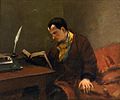Matsuo Bashō
Welcome to the Poetry Portal


Poetry (from the Greek word poiesis, "making") is a form of literary art that uses aesthetic and often rhythmic qualities of language to evoke meanings in addition to, or in place of, literal or surface-level meanings. Any particular instance of poetry is called a poem and is written by a poet.
Poets use a variety of techniques called poetic devices, such as assonance, alliteration, euphony and cacophony, onomatopoeia, rhythm (via metre), and sound symbolism, to produce musical or other artistic effects. They also frequently organize these effects intos, which may be strict or loose, conventional or invented by the poet. Poetic structures vary dramatically by language and cultural convention, but they often use rhythmic metre (patterns of syllable stress or syllable (mora) weight). They may also use repeating patterns of phonemes, phoneme groups, tones (phonemic pitch shifts found in tonal languages), words, or entire phrases. These include consonance (or just alliteration), assonance (as in the dróttkvætt), and rhyme schemes (patterns in rimes, a type of phoneme group). Poetic structures may even be semantic (e.g. the volta required in a Petrachan sonnet).
Most written poems are formatted in verse: a series or stack of lines on a page, which follow the poetic structure. For this reason, verse has also become a synonym (a metonym) for poetry. (Full article...)
Selected article

A villanelle, also known as villanesque, is a nineteen-line poetic form consisting of five tercets followed by a quatrain. There are two refrains and two repeating rhymes, with the first and third lines of the first tercet repeated alternately at the end of each subsequent stanza until the last stanza, which includes both repeated lines. The villanelle is an example of a fixed verse form. The word derives from Latin, then Italian, and is related to the initial subject of the form being the pastoral.
The form started as a simple ballad-like song with no fixed form; this fixed quality would only come much later, from the poem "Villanelle (J'ay perdu ma Tourterelle)" (1606) by Jean Passerat. From this point, its evolution into the "fixed form" used in the present day is debated. Despite its French origins, the majority of villanelles have been written in English, a trend which began in the late nineteenth century. The villanelle has been noted as a form that frequently treats the subject of obsessions, and one which appeals to outsiders; its defining feature of repetition prevents it from having a conventional tone. (Full article...)
Selected image
Poetry WikiProject

Selected biography

William Shakespeare (baptised April 26, 1564 – died April 23, 1616) was an English poet and playwright widely regarded as the greatest writer of the English language, as well as one of the greatest in Western literature, and the world's preeminent dramatist. He wrote about 38 plays and 154 sonnets, as well as a variety of other poems. Already a popular writer in his own lifetime, Shakespeare's reputation became increasingly celebrated after his death and his work adulated by numerous prominent cultural figures through the centuries. In addition, Shakespeare is the most quoted writer in the literature and history of the English-speaking world. He is often considered to be England's national poet and is sometimes referred to as the "Bard of Avon" (or simply "The Bard" or the "Swan of Avon"). (Full article...)
Did you know (auto-generated) -

- ... that the poet Fernando Pessoa considered Alberto Caeiro, one of his own heteronyms, to be his master?
- ... that Jan Kochanowski's Fraszki is a 16th-century collection of almost 300 poems, ranging from anecdotes and epitaphs to obscenities and erotica?
- ... that scholarly study of the poetry of Kishvari, one of the most important Azerbaijani poets of the 15th and 16th centuries, only started in 1928?
- ... that Chadd Cumberbatch, a Montserratian poet and playwright, wrote a play called 1768 to tell the story of the island's St Patrick's Day slave rebellion?
- ... that creating visual art led Maya Pindyck to write poetry?
- ... that Ove Jørgensen, after giving his name to a law of Homeric poetry, renounced classical studies to write about ballet?
Selected poem
| Bhagavad Gita (excerpt, chapter 11) by anonymous |
|---|
|
Behold! this is the Universe! — Look! what is live and dead |
Related portals
Topics
Recognized content
Categories
Associated Wikimedia
The following Wikimedia Foundation sister projects provide more on this subject:
-
 Commons
Commons
Free media repository -
 Wikibooks
Wikibooks
Free textbooks and manuals -
 Wikidata
Wikidata
Free knowledge base -
 Wikinews
Wikinews
Free-content news -
 Wikiquote
Wikiquote
Collection of quotations -
 Wikisource
Wikisource
Free-content library -
 Wikiversity
Wikiversity
Free learning tools -
 Wiktionary
Wiktionary
Dictionary and thesaurus

 Read
Read
 AUTHORPÆDIA is hosted by Authorpædia Foundation, Inc. a U.S. non-profit organization.
AUTHORPÆDIA is hosted by Authorpædia Foundation, Inc. a U.S. non-profit organization.













